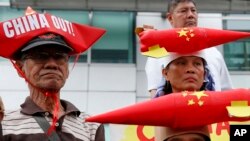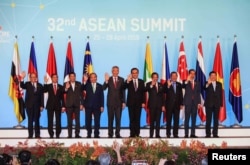Beijing weathered only light protests against its reported missile installations in the Spratly Islands, making it easier to strengthen its military outposts in the disputed South China Sea, analysts say.
Vietnam demanded May 8 that China remove any missiles but did not push further. The Philippines has “active mechanisms” to discuss militarization of the South China Sea but does not see Beijing as a threat, a presidential office spokesman in Manila said last week. Both countries, along with Brunei, Malaysia and Taiwan, claim waters where China reportedly deployed anti-ship and surface-to-air missiles in April.
The lack of further protest gives China a clear channel to keep any missiles in place on the three Spratly islets where it has built installations over the past two years and add more weapons systems, experts say. China said last week it was testing bombers.
“The fizzling of regional protests against Beijing’s installation of missiles in the South China Sea means Beijing’s hegemony over said vast body of water is now a virtual fait accompli,” said Sean King, vice president of the Park Strategies political consultancy in New York. “There’s not much left that anyone can do about it.”
Rival maritime claimants
Beijing claims about 90 percent of the South China Sea, overlapping waters that the five other governments say belongs to them. China has irked the others since 2010 by landfilling tiny islets, in some cases for military installations. The sea that stretches from Taiwan to Singapore is prized for fisheries, shipping lanes, oil and gas.
Vietnam, the Philippines, Brunei and Malaysia all depend heavily on trade or investment from China, making them less likely to protest, analysts say. Malaysia counts China as its top source of foreign investment, for example, while Vietnam saw tourism from China grow 49 percent to four million arrivals in 2017.
Southeast Asian rivals “don’t complain more loudly because they all need Beijing economically,” King said.
Philippine President Rodrigo Duterte will approach China not in protest but with an “open, frank, candid, and frontal discussion,” his spokesman Harry Roque said last week. The country has a “newfound friendship with China,” Roque added, referring to a diplomatic warming since 2016, after four years of open disputes over maritime sovereignty.
The 10-member Association of Southeast Asian Nations, or ASEAN, hopes to sign a deal with China on preventing mishaps at sea. All four Southeast Asian maritime claimants are ASEAN members.
Prospect of more militarization
China can add with little risk to its weaponry in the sea’s Spratly and Paracel island chains, said Termsak Chalermpalanupap, a fellow with the ISEAS Yusof Ishak Institute in Singapore.
On Friday the Chinese air force said via social media it had landed bombers for the first time in the South China Sea with a mission to Woody Island in the Paracel chain.
It did that to “show they have the capability,” Chalermpalanupap said. China may install more anti-ship missiles later, he said.
Woody Island is a “blueprint” for eventual deployments to the Spratly Islands, the Asia Maritime Transparency Initiative under U.S. think tank Center for Strategic and International Studies says on its website. China has hangars at its three major Spratly islets -- Subi, Mischief, and Fiery Cross reefs – that can handle bombers as well as aircraft for transport, patrol and refueling, it says.
“I think that what China is doing is that regardless of the reaction from ASEAN countries or ASEAN itself or from other external powers, so long as whatever it’s doing doesn’t cross the threshold of hostilities, then I think China is more than willing to do what it is already doing, I mean including those buildups,” said Collin Koh, maritime security research fellow at Nanyang Technological University in Singapore.
The Philippine presidential office said Monday it would talk to China about reports of bombers in the sea.
Deterrent for Washington
China may be building up weapons to deter the United States and its powerful allies outside Southeast Asia from challenging its claim, experts believe.
“They just want to do just whatever they can, maybe just to intimidate the U.S. Navy from sailing too close to their artificial islands,” Chalermpalanupap said.
The U.S. Navy will probably keep passing ships through the sea to advocate that the waterway stay open for international use, he said. The government of U.S. President Donald Trump has ordered six such missions.
But Washington “won’t do much of anything” if Beijing further militarizes the sea, King said. The U.S. government lacks its own maritime claim there, he notes, and its major regional treaty ally, the Philippines, isn’t pressuring China.








